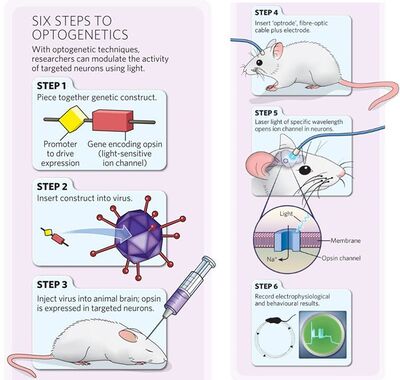Optogenetics
(medical concept, genetic modification, social control, transhumanism) | |
|---|---|
 | |
| Interest of | Feng Zhang |
| A biological technique that involves the use of light to control neurons;A Virtual Reality System for Controlling Living Cells | |
Optogenetics is a biological technology that makes it possible to control cellular activity with light. For this purpose, foreign genes are introduced into the target cells, which lead to the expression of light-sensitive pore-forming membrane proteins called ion channels. [1] If targeted precisely enough with the appropriate light, it's thought that optogenetics could be used by manipulating neural circuits involved with pain, fear, reward, wakefulness and social behaviors, [2] plus having an enormous potential in the development of brain-machine interfaces.
Description
| Optogenetics: Using Light to Control Your Brain |
The technology is a combination of methods from optics and genetics, with the aim of activating (gain-of-function) or deactivating (loss-of-function) certain functional events in specific cells or living tissues. Light-sensitive proteins are genetically modified by manipulating the coding DNA (i.e. the corresponding gene) and then introduced into certain target cells or tissue. Under the influence of light, it is then possible to control the behavior of the cells modified in this way.[3]
Optogenetics allows a targeted and extremely fast (millisecond range) control of precisely defined events in complex biological systems. This enables investigations at the protein level (applications in molecular biology), at the level of individual cells (cell biology) and defined tissues (histology) or even at the level of freely moving mammals (behavioral biology).
The technology, which was named “Method of the Year 2010” by the scientific journal Nature Methods, is being tested in animal models of Parkinson's and epilepsy.[3][4]
Optogenetic methods are already used today to identify different intracellular processes, such as to research or control the localization of proteins in certain regions of the cell. Through this targeted modification, cell biology is currently experiencing an increase in knowledge about intracellular processes that was hardly imaginable a few years ago. In a broader sense, fluorescent proteins are also counted among the optogenetic tools that allow cellular activity to be measured with light. Also in neurobiology, where the process was first developed, it enables previously unthinkable detailed insights into the functioning of the nervous system and the brain.
The Walking Dead
In 2017, The Guardian described an experiment by the Yale University School of Medicine led by psychiatry researcher Ivan de Araujo that was able to "bypass the usual sensory requirements and could trigger the predation circuits artificially using lasers" in rats:
all the trappings of a classic horror plot: a group of normally timid individuals are transformed by scientists into instinctive killers, programmed to pursue and sink their jaws into almost anything that crosses their path. The research revealed that one set of neurons triggers the pursuit of prey, while another prompts the animal to clench its jaws and neck muscles to bite and kill. When the laser was off in the experiment, the animals behaved normally, but at the flick of a switch they assumed qualities of “walkers” from The Walking Dead...The scientists identified two separate clusters of neurons in the central amygdala, a brain area normally linked to emotion and motivation. These were shown to be communicating with other neurons in two motor areas – in one case, a region linked to the ability to run and change speed and, in the other, a region known to control jaw and neck movements.[5]
Military research
In 2017, the US military research agency DARPA granted $21.6 million to UC Berkeley as part of its Neural Engineering System Design program. The team led by Ehud Isacoff, director of the Helen Wills Neuroscience Institute at UC Berkeley, aims to develop a novel brain-machine interface that uses light to monitor and modulate the activity of thousands to millions of individual neurons in the cerebral cortex. DARPA’s ultimate goal is to accelerate the development of biocompatible neural implants for use in humans to compensate for sensory deficits or to control prosthetic devices[6] (like weapons).
In 2015, optogenetics was combined with CRISPR to develop a set of photoactivatable tools that enable the editing of an organism's genome through the external use of light. The tools can control the location, timing and reversibility of the genome editing process, whether that be activating, repressing or modifying a gene.[7]
In the past, DARPA has looked to optogenetic memory manipulation techniques for treating veterans with traumatic brain injury and/or PTSD through memory restoration or deletion.[8]
It's believed that optogenetics and its surrounding bodies of research may open the door to real-time brain mapping and biofeedback technologies.
To investigate the therapeutic use of optogenetics, acoustics and electromagnetic fields, DARPA launched the ElectRX (Electrical Prescription)[9][10] program in 2015, which is capable of stimulating, modulating and monitoring the body's peripheral nervous system. The research agency is also exploring how artificial intelligence could be used in closed-loop brain implants, such as the ability to detect patterns associated with mood disorders[11], like unhappiness, disloyalty or rebelliousness.
References
- ↑ Flief Fenno, Ofer Yizhar, Karl Deisseroth: The Development and Application of Optogenetics. In: Annual Review of Neuroscience. Band 34, Nr. 1, 21. Juli 2011 https://doi.org/10.1146/annurev-neuro-061010-113817
- ↑ https://www.biologicalpsychiatryjournal.com/issue/S0006-3223(11)X0036-7
- ↑ Jump up to: a b Karl Deisseroth: Optogenetics. In: Nature Methods. Band 8, Nr. 1, 2011, S. 26–29 https://doi.org/10.1038/nmeth.f.324
- ↑ http://www.nature.com/nmeth/focus/moy2010/index.html
- ↑ https://www.theguardian.com/science/2017/jan/12/scientists-use-light-to-trigger-walking-dead-killer-instinct-in-mice-optogenetics
- ↑ https://biosciences.lbl.gov/2017/07/24/darpa-optogenetic-neural-interface/
- ↑ https://blog.addgene.org/optogenetics-crispr-using-light-to-control-genome-editing
- ↑ https://www.executivegov.com/2015/10/hdiac-dod-darpa-program-looks-into-memory-manipulation-to-treat-ptsd-tbi/
- ↑ https://www.darpa.mil/program/electrical-prescriptions
- ↑ https://www.kurzweilai.net/darpa-selects-research-teams-for-its-electrx-neuron-sensingstimulation-program
- ↑ https://www.nature.com/news/ai-controlled-brain-implants-for-mood-disorders-tested-in-people-1.23031
Wikipedia is not affiliated with Wikispooks. Original page source here